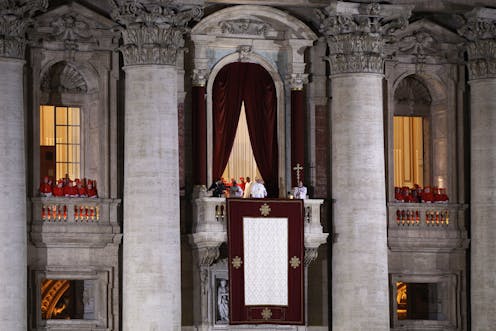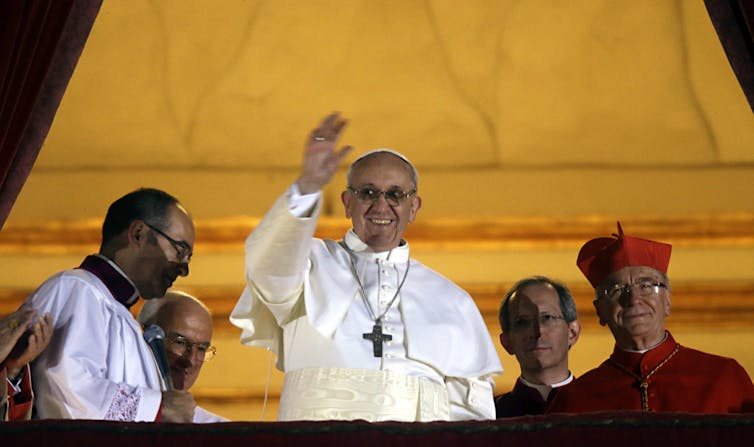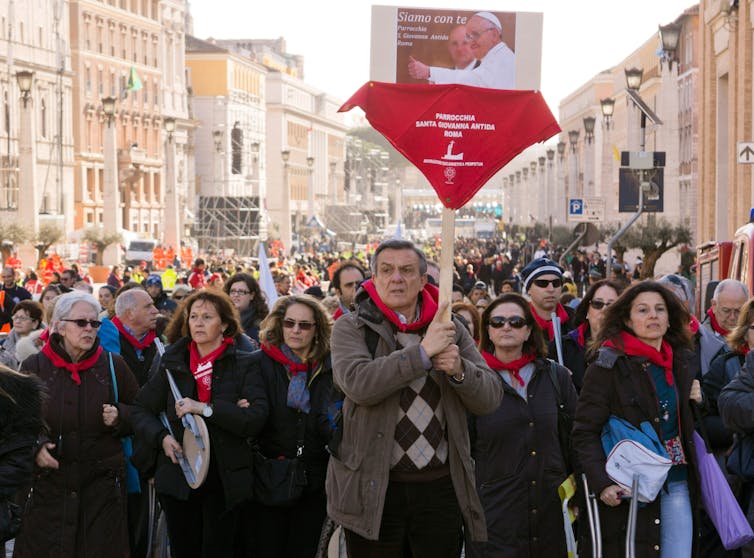A new pope’s first appearance on St. Peter’s balcony is rich with symbols − and Francis’ decision to rein in the pomp spoke volumes
- Written by Daniel Speed Thompson, Associate Professor of Religious Studies, University of Dayton
 Pope Francis stands at the central balcony of St. Peter's Basilica at the Vatican on March 13, 2013, just after being announced as pontiff.AP Photo/Andrew Medichini
Pope Francis stands at the central balcony of St. Peter's Basilica at the Vatican on March 13, 2013, just after being announced as pontiff.AP Photo/Andrew MedichiniAs the College of Cardinals gathers in the Sistine Chapel to vote for a new pope, crowds outside will watch for the most dramatic moment of the conclave, when a wisp of white smoke appears above the chimney.
This smoke – made by burning the ballots – indicates that a new pope has been elected and he has accepted.
After a short period of time, a cardinal appears on the balcony of St. Peter’s Basilica and makes the announcement in Latin: “Habemus papam!” – “We have a pope!” He then announces which cardinal has been selected and which name the new pope has chosen for himself.
Finally, the new pope appears on the balcony and greets the crowd in St. Peter’s Square – a tradition full of symbolism.
I am a scholar who studies Roman Catholic theology and history. I am particularly interested in how popes exercise authority and leadership today, including their use of symbols. When Pope Francis first appeared on that balcony in 2013, he used and adapted the ritual to convey a message about his intentions for his papacy.
He did this in four ways.
What’s in a name?
First, he chose the name Francis. Since the sixth century C.E., new bishops of Rome have often taken a new name when they assumed the papacy.
Over time, certain names have indicated to observers the direction that a pope wished to take or a model whom he wished to emulate. Jorge Mario Bergoglio opted for “Francis,” the first time that any pope had assumed that name.
It refers to Francis of Assisi, an Italian saint who lived at the turn of the 13th century who was renowned for his simplicity, poverty, concern for the Earth and desire to imitate Jesus. Over the next 12 years, these traits proved central to his papacy.
Not a king
Second, Francis wore simple white papal garments instead of the more elaborate adornments worn by some of his predecessors. He wore his old, simple cross across his chest, rather than a new, more luxurious one.
 Francis waves during his first appearance as pope on March 13, 2013.AP Photo/Dmitry Lovetsky
Francis waves during his first appearance as pope on March 13, 2013.AP Photo/Dmitry LovetskyPopes have worn white garments as a symbol of their office for centuries. But many of them also used symbols of monarchy, such as the triple papal tiara or crown. Pope Paul VI, whose papacy was from 1963-1978, was the last to wear the tiara and to have a coronation ceremony. The following year, he sold the crown and donated the proceeds to emphasize the church’s commitment to the poor.
Later popes have followed Paul’s example of avoiding royal symbolism, such as by no longer using a “sedia gestatoria,” the portable throne that traditionally carried the pope in formal processions. Francis took this trend even further and made simplicity of dress and lifestyle a hallmark of his time in office.
Bishop of Rome
Third, when Francis first addressed the crowd in St. Peter’s, he described himself as the new bishop of Rome.
In Catholicism, the pope holds many titles representing the scope and duties of his office. For starters, he is not only the spiritual leader of the Roman Catholic Church but “sovereign of the State of Vatican City.”
In terms of religious titles, some accentuate the pope’s authority. “Vicar of Christ,” for example, means he is Jesus’ representative on Earth. Others, such as “servus servorum Dei” – “servant of the servants of God” – emphasize his role as a support to other bishops and ministers of the church.
Francis certainly did not deny the traditional authority of the pope’s office. However, he chose to identify himself first as the local bishop of the diocese of Rome, emphasizing how even the pope was first part of a local community. In the official Vatican yearbook for 2020, Francis listed his only title as “Bishop of Rome” and listed the rest as “historic.”
 Catholics from the parish of St. Joan Antida in Rome arrive to attend Pope Francis’ inaugural Mass at the Vatican on March 19, 2013.AP Photo/Domenico Stinellis
Catholics from the parish of St. Joan Antida in Rome arrive to attend Pope Francis’ inaugural Mass at the Vatican on March 19, 2013.AP Photo/Domenico Stinellis‘Pray for me’
Fourth, Francis asked the assembled crowd to pray for him before he offered his first papal blessing.
Traditionally, popes making their first appearance would offer a blessing to the people gathered in St. Peter’s Square. Francis took this ritual and reversed it. In harmony with his views on simplicity and his role as the bishop of Rome, he emphasized the mutual connection between him and the people. He downplayed the view of the pope as a hierarchical ruler above the people.
Sometime soon a new pope will be introduced to the world. He will likely use these symbols of name, dress, title and blessing in his own way, pointing to his intentions for his papacy and for the Catholic Church.
Daniel Speed Thompson does not work for, consult, own shares in or receive funding from any company or organization that would benefit from this article, and has disclosed no relevant affiliations beyond their academic appointment.
Authors: Daniel Speed Thompson, Associate Professor of Religious Studies, University of Dayton

